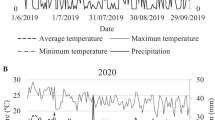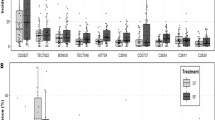Abstract
The epidemiology of northern leaf blight of corn, caused byExserohilum turcicum (Pass.) Leonard and Suggs, is reviewed. The minimal dew period required for infection is temperature-dependent. At 25°C, 1 h of dew is sufficient to cause infection and at this temperature the minimal dew period for sporulation is 14 h. Under natural conditions when one dew night is not long enough for conidia to develop, the dew period on the following night enables the completion of conidial formation. The amount of conidia formed is dependent on temperature, light, plant age, leaf position and plant susceptibility. Both qualitative and quantitative types of resistance were identified in several hybrids. Subsequently, there developed additional biotypes ofE. turcicum which are aggressive to plants containing qualitative monogenic resistance. Within the same physiological race, a significant variation in aggressiveness between isolates from various locations is observed.
The pathogen overwinters as mycelia and conidia in infected leaves, husks and other plant parts, or onSorghum halepense L. Reduction in yield due to northern leaf blight is associated with the level of resistance of the host plant, with disease severity, plant age during infection, and position of infected leaves.
Similar content being viewed by others
References
Abadi, R., Levy, Y. and Bar-Tsur, A. (1989) Physiological races ofExserohilum turcicum in Israel.Phytoparasitica 17:22–30.
Asare-Nyako, A. (1964) Germination ofHelminthosporium turcicum conidia overwintered in Minnesota soil.Phytopathology 54:886 (abstr.).
Berger, R.D. (1970) ForecastingHelminthosporium turcicum attacks in Florida sweet corn.Phytopathology 60:1284.
Berger, R.D. (1973)Helminthosporium turcicum lesion numbers related to numbers of trapped spores and fungicide sprays.Phytopathology 63:930–933.
Bergquist, R.R. and Masias, O.R. (1974) Physiologic specialization inTrichometasphaeria turcica f. sp.zeae andTrichometasphaeria turcica f. sp.sorghi in Hawaii.Phytopathology 64:645–649.
Boldkvadze, Z.A. (1972) The effect of weather conditions on sporulation ofHelminthosporium turcicum.Mikol. Fitopatol. 6:536–537.
Boosalis, M.G., Sumner, D.R. and Rao, A.S. (1967) Overwintering ofHelminthosporium turcicum on corn residue and in soil in Nebraska.Phytopathology 57:990–996.
Bowen, K.L. and Pedersen, W.L. (1988) Effects of northern leaf blight and detasseling on yields and yield components of corn inbreds.Plant Dis. 72:952–956.
Browder, L.E. (1985) Parasite: host: environment specificity in the cereal rusts.Annu. Rev. Phytopathol. 23:201–222.
Calub, A.G., Dunn, G.M. and Routley, D.G. (1973) Effects of genetic background on monogenic resistance toHelminthosporium turcicum in maize (Zea mays L.).Crop Sci. 13:561–563.
Cimmyt. (1988) Maize production regions in developing countries. Internal report of CIMMYT’s maize program. Mexico. 137 pp.
Elliott, C. and Jenkins, M.T. (1946)Helminthosporium turcicum leaf blight of corn.Phytopathology 36:660–666.
Fisher, D.E., Hooker, A.L., Lim, S.M. and Smith, D.R. (1976) Leaf infection and yield loss caused by fourHelminthosporium leaf diseases of corn.Phytopathology 66:942–944.
Fullerton, R.A. and Fletcher, J.D. (1974) Observations on the survival ofDrechslera turcica in maize debris in New Zealand.N.Z. J. Agric. Res. 17:153–155.
Gevers, H.O. (1975) A new major gene for resistance toHelminthosporium turcicum leaf blight of maize.Plant Dis. Rep. 59:296–299.
Hilu, H.M. and Hooker, A.L. (1963) Monogenic chlorotic lesion resistance toHelminthosporium turcicum in corn seedlings.Phytopathology 53:909–912.
Hooker, A.L. (1961) A new type of resistance in corn toHelminthosporium turcicum.Plant Dis. Rep. 45:780–781.
Hooker, A.L. (1963) Inheritance of chlorotic-lesion resistance toHelminthosporium turcicum in seedling corn.Phytopathology 53:660–662.
Hooker, A.L. (1963) Monogenic resistance inZea mays L. toHelminthosporium turcicum.Crop Sci. 13:787–788.
Hooker, A.L. (1977) A second major gene locus in corn for chlorotic-lesion resistance toHelminthosporium turcicum.Crop Sci. 17:132–135.
Hooker, A.L. (1978) Additional sources of monogenic resistance in corn toHelminthosporium turcicum.Crop Sci. 18:787–788.
Hooker, A.L. (1979) Estimating disease losses based on the amount of healthy leaf tissue during the plant reproductive period.Genetika 11:181–192.
Hooker, A.L., Hilu, H.M. and Wilkinson, D.R. (1964) Additional sources of chlorotic-lesion resistance toHelminthosporium turcicum in corn.Plant Dis. Rep. 48:777–780.
Hooker, A.L. and Kim, S.K. (1973) Monogenic and multigenic resistance toHelminthosporium turcicum in corn.Plant Dis. Rep. 57:586–589.
Hooker, A.L. and Perkins, J.M. (1980) Helminthosporium leaf blights of corn — the state of the art.Proc. 35th Annu. Corn and Sorghum Res. Conf., Am. Seed Trade Assoc. (Chicago, IL), pp. 68-87.
Hoppe, P.E. (1962) Does the corn leaf blight fungus survive Wisconsin winters?Plant Dis. Rep. 46:444–445.
Hoppe, P.E. and Arny, D.C. (1966) Factors affecting the survival ofHelminthosporium turcicum in corn leaf tissues.Plant Dis. Rep. 50:377–380.
Hughes, G.R. and Hooker, A.L. (1971) Gene action conditioning resistance to northern leaf blight.Crop Sci. 11:180–184.
James, W.C. (1974) Assessment of plant disease and losses.Annu. Rev. Phytopathol. 12:27–48.
Jenkins, M.T. and Robert, A.L. (1952) Inheritance of resistance to the leaf blight of corn caused byHelminthosporium turcicum.Agron. J. 44:136–140.
Jenkins, M.T. and Robert, A.L. (1959) Evaluating the breeding potential of inbred lines of corn resistance to the leaf blight of corn caused byHelminthosporium turcicum.Agron. J. 51:93–96.
Jenkins, M.T., Robert, A.L. and Findley, W.R. Jr. (1952) Inheritance of resistance toHelminthosporium turcicum leaf blight in populations of F3 progenies.Agron. J. 44:438–442.
Jenkins, M.T., Robert, A.L. and Findley, W.R. Jr. (1954) Recurrent selection as a method for concentrating genes for resistance toHelminthosporium turcicum leaf blight in corn.Agron. J. 46:89–94.
Jordan, E.G., Perkins, J.M., Schall, R.A. and Pedersen, W.L. (1983) Occurrence of race 2 ofExserohilum turcicum in the central and eastern United States.Plant Dis. 67:1163–1165.
Keller, N.P. and Bergstrom, G.C. (1990) Predominance in New York of isolates ofExserohilum turcicum virulent on maize with the geneHtl.Plant Dis. 74:530.
Leach, C.M., Fullerton, R.A. and Young, K. (1977) Northern leaf blight of maize in New Zealand: relationship ofDrechslera turcica airspora to factors influencing sporulation, conidium development and chlamydospore formation.Phytopathology 67:629–636.
Leath, S. and Pedersen, W.L. (1986) Effects of theHt, Ht2, and/orHt3 genes in three maize inbreds on quantitative resistance toExserohilum turcicum race 2.Plant Dis. 70:529–531.
Leath, S., Thakur, R.P. and Leonard, K.J. (1990) Variation in expression of monogenic resistance in corn toExserohilum turcicum race 3 under different temperature and light regimes.Phytopathology 80:309–313.
Leonard, K.J., Levy, Y. and Smith, D.R. (1989) Proposed nomenclature for pathogenic races ofExserohilum turcicum on corn.Plant Dis. 73:776–777.
Leonard, K.J., Thakur, R.P. and Leath, S. (1988) Incidence ofBipolaris andExserohilum species in corn leaves in North Carolina.Plant Dis. 72:1034–1038.
Levy, Y. (1984) Overwintering ofExserohilum turcicum in Israel.Phytoparasitica 12:177–182.
Levy, Y. (1989) Analysis of epidemics of northern leaf blight on sweet corn in Israel.Phytopathology 79:1243–1245.
Levy, Y. (1991) Variation in fitness among field isolates ofExserohilum turcicum in Israel.Plant Dis. 75:163–166.
Levy, Y. and Cohen, Y. (1979) Seasonal fluctuations in epidemics of the northern leaf blight of corn in Israel.Phytoparasitica 7:59–60 (abstr.).
Levy, Y. and Cohen, Y. (1980) Sporulation ofHelminthosporium turcicum on sweet corn: effects of temperature and dew period.Can. J. Plant Pathol. 2:65–69.
Levy, Y. and Cohen, Y. (1981) Sporulation ofHelminthosporium turcicum on sweet corn: effects of light and sugars.Physiol. Plant Pathol. 18:17–25.
Levy, Y. and Cohen, Y. (1983) Differential effects of light on spore germination ofHelminthosporium turcicum on corn leaves and corn leaf impressions.Phytopathology 73:249–252.
Levy, Y. and Cohen, Y. (1983) Biotic and environmental factors affecting infection of sweet corn withExserohilum turcicum.Phytopathology 73:722–725.
Levy, Y. and Cohen, Y. (1983) Differential sensitivity to dryness of conidia ofExserohilum turcicum on corn leaves and on artificial media.Can. J. Plant Pathol. 5:235–238.
Levy, Y. and Leonard, K.J. (1990) Yield loss in sweet corn in response to defoliation or infection byExserohilum turcicum.J. Phytopathol. 128:161–171.
Lim, S.M., Kinsey, J.G. and Hooker, A.L. (1974) Inheritance of virulence inHelminthosporium turcicum to monogenic resistant corn.Phytopathology 64:1150–1151.
Meridith, D.S. (1965) Violent spore release inHelminthosporium turcicum in Nebraska.Phytopathology 55:1099–1101.
Meridith, D.S. (1966) Airborne conidia ofHelminthosporium turcicum in Nebraska.Phytopathology 56:949–952.
Meyer, A.C., Pataky, J.K. and Juvik, J.A. (1991) Partial resistance to northern leaf blight and Stewart’s wilt in sweet corn germplasm.Plant Dis. 75:1094–1097.
Nelson, R.R., MacKenzie, D.R. and Schiefele, G.L. (1970) Interaction of genes for pathogenicity and virulence inTrichometasphaeria turcica with different numbers of genes for vertical resistance inZea mays.Phytopathology 60:1250–1254.
Pataky, J.K. (1989) Illinois sweet corn hybrid disease nursery — 1989.in: Simon, J.E., Cebert, E. and Daniels, D.D. [Eds.] Midwest Vegetable Cultivar Report for 1989.Purdue Univ. Agric. Exp. Sta. Bull. 577:148–154.
Pataky, J.K. (1991)Exserohilum turcicum on sweet corn in Florida.Phytopathology 81:813 (abstr.).
Pataky, J.K., Fallah Mogahaddam, P. and Gantz, J.W. (1990) Illinois sweet corn hybrid disease nursery — 1990.in: Simon, J.E., Daniels, D.D. and Morales, M. [Eds.] Midwest Vegetable Cultivar Report for 1990.Purdue Univ. Agric. Exp. Sta. Bull. 600:170–179.
Pataky, J.K. and Headrick, J.M. (1988) Illinois sweet corn hybrid disease nursery — 1988.in: Simon, J.E., Daniels, D.D. and Morales, M. [Eds.] Midwest Vegetable Cultivar Report for 1988.Purdue Univ. Agric. Exp. Sta. Bull. 551:100–107.
Pataky, J.K., Headrick, J.M. and Suparyono. (1988) Classification of sweet corn hybrid disease reactions to common rust, northern leaf blight, Stewart’s wilt, and Goss’s wilt and associated yield reductions.Phytopathology 78:172–178.
Pataky, J.K., Perkins, J.M. and Leath, S. (1986) Effects of qualitative and quantitative resistance on the development and spread of northern leaf blight of maize caused byExserohilum turcicum races 1 and 2.Phytopathology 76:1349–1352.
Perkins, J.M. and Hooker, A.L. (1981) Reactions of eighty-four sources of chlorotic lesion resistance to three biotypes ofHelminthosporium turcicum.Plant Dis. 65:502–504.
Perkins, J.M. and Pedersen, W.L. (1987) Disease development and yield losses associated with northern leaf blight on corn.Plant Dis. 71:940–943.
Raymundo, A.D. (1978) Epidemiology of northern corn leaf blight as affected by host resistance and yield losses following simulated epidemics. Ph.D. thesis, University of Illinois, Urbana, IL.
Raymundo, A.D. and Hooker, A.L. (1981) Effect of geneHtN on the development of northern corn leaf blight epidemics.Plant Dis. 65:327–330.
Raymundo, A.D. and Hooker, A.L. (1981) Measuring the relationship between northern corn leaf blight and yield losses.Plant Dis. 65:325–327.
Raymundo, A.D. and Hooker, A.L. (1982) Single and combined effects of monogenic and polygenic resistance on certain components of northern corn leaf blight development.Phytopathology 72:99–103.
Robert, A.L. (1960) Physiologic specialization inHelminthosporium turcicum.Phytopathology 50:217–220.
Robert, A.L. (1964) The effect of temperature and relative humidity on longevity ofTrichometasphaeria turcica.Plant Dis. Rep. 36:9–10.
Robert, A.L. and Findley, W.R. (1952) Diseased corn leaves as a source of infection in artificial and natural epidemics ofHelminthosporium turcicum.Plant Dis. Rep. 36: 9–10.
Robert, A.L. and Sprague, G.F. (1960) Adaptation of the corn leaf blight fungus to a resistant and a susceptible corn host.Phytopathology 50:261–263.
Rotem, J., Cohen, Y. and Bashi, E. (1979) Host and environmental influences on sporulationin vivo.Annu. Rev. Phytopathol. 16:83–101.
Royer, M.H., Nelson, R.R., MacKenzie, D.R. and Diehle, D.A. (1984) Partial resistance of near-isogenic lines compatible withErysiphe graminis f. sp.tritici. Phytopathology 74:1001–1006.
Shurtleff, M.C. (1980) Compendium of Corn Diseases. American Phytopathology Society, St. Paul, MN.
Sigulas, K.M., Hill, R.R. Jr. and Ayers, J.E. (1988) Genetic analysis ofExserohilum turcicum lesion expansion on corn.Phytopathology 78:149–153.
Simone, G.W. (1978) Inheritance of resistance in fifteen corn selections toHelminthosporium turcicum. Ph.D. thesis, University of Illinois, Urbana, IL.
Smith, D.R. (1984) Monitoring corn pathogens nationally.in: Alexander, D.E. [Ed.]Proc. 20th Annu. Illinois Corn Breeders School (Univ. of Illinois, Champaign, IL), pp. 101–136.
Smith, D.R. and Kinsey, J.G. (1980) Further physiologic specialization inHelminthosporium turcicum.Plant Dis. 64:779–781.
Thakur, R.P., Leonard, K.J. and Jones, R.K. (1989) Characterization of a new race ofExserohilum turcicum virulent on corn with resistance geneHtN.Plant Dis. 73:151–155.
Thakur, R.P., Leonard, K.J. and Leath, S. (1989) Effects of temperature and light on virulence ofExserohilum turcicum on corn.Phytopathology 79:631–635.
Turner, M.T. and Hart, K. (1975) Field spore production ofHelminthosporium turcicum onZea mays with and without monogenic resistance.Phytopathology 65:735–736.
Turner, M.T. and Johnson, E.R. (1980) Race ofHelminthosporium turcicum not controlled byHt genetic resistance in corn in the American corn belt.Plant Dis. 64:216–217.
Ullstrup, A.J. (1963) Sources of resistance to northern corn leaf blight.Plant Dis. Rep. 47:107–108.
Ullstrup, A.J. (1970) A comparison of monogenic and polygenic resistance toHelminthosporium turcicum.Phytopathology 60:1597–1599.
Ullstrup, A.J. and Miles, S.R. (1957) The effects of some leaf blights of corn on grain yield.Phytopathology 47:331–336.
Waggoner, P.E. and Berger, R.D. (1987) Disease, defoliation and growth.Phytopathology 77:393–398.
Wilson, G.F. and Rhodes, A.M. (1970) Similarity of five sources of chlorotic-lesion resistance toHelminthosporium turcicum in a sweet corn background.Plant Dis. Rep. 54:896–897.
Windes, J.M. and Pedersen, W.L. (1991) An isolate ofExserohilum turcicum virulent on maize with resistant gene HtN.Plant Dis. 73:430.
Author information
Authors and Affiliations
Rights and permissions
About this article
Cite this article
Levy, Y., Pataky, J.K. Epidemiology of Northern leaf blight on sweet corn. Phytoparasitica 20, 53–66 (1992). https://doi.org/10.1007/BF02995636
Received:
Revised:
Issue Date:
DOI: https://doi.org/10.1007/BF02995636




